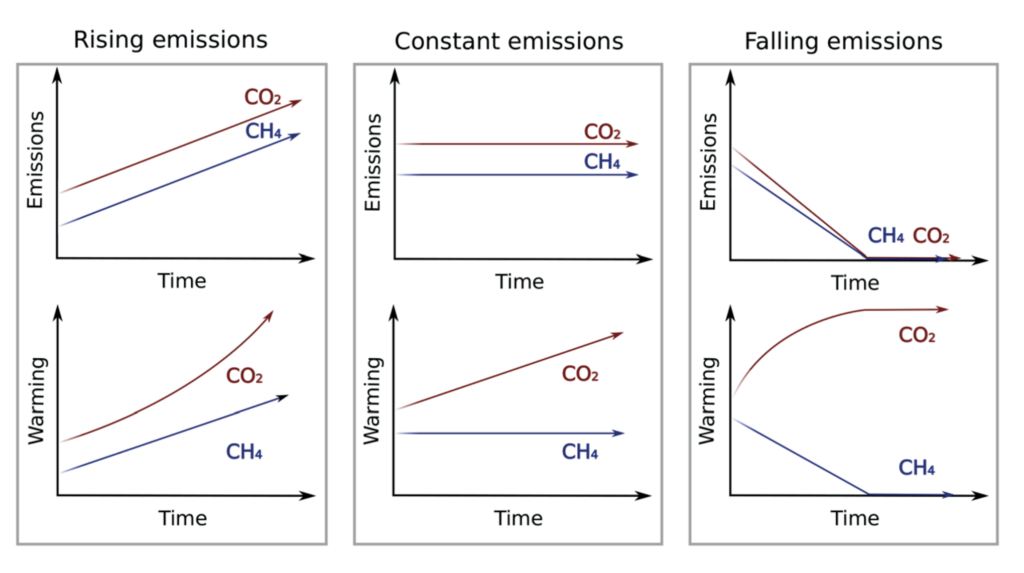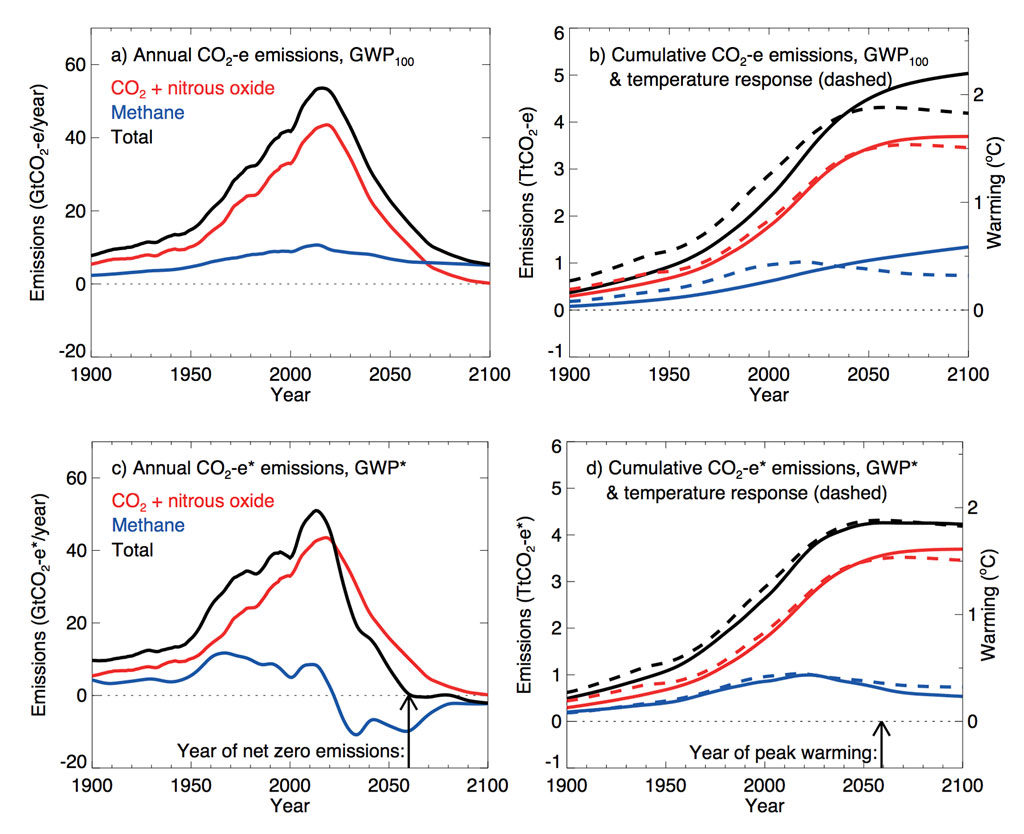
Guest post: A new way to assess ‘global warming potential’ of short-lived pollutants

Dr Michelle Cain
06.07.18
Dr Michelle Cain
07.06.2018 | 10:08amDr Michelle Cain in a science and policy research associate on the Oxford Martin School’s programme on climate pollutants at the University of Oxford.
The Paris Agreement on climate change envisages a periodic “stocktake” for countries to assess whether their emissions reduction targets, and progress towards them, are on track to meet the long-term temperature goal. Or if they fall short and need adjusting.
At the moment, it is not obvious how this will be done. In a new paper published in npj Climate and Atmospheric Science, my co-authors and I address one of the stocktake’s key stumbling blocks – the treatment of all greenhouse gases as “CO2-equivalent”, using a metric known as “global warming potential” (GWP). This misrepresents the impact of short-lived climate pollutants, such as methane, on future warming.
We show that modifying the use of GWP, so that it accounts for the differences between short- and long-lived gases, can better link emissions to warming. This means that the true impact of an emission pathway on global temperature can be easily assessed. For countries with high methane emissions – due to, say, agriculture – this can make a huge difference to how their progress in emission reductions is judged.
GWP masks true effects of short-lived gases
Greenhouse gas emissions are commonly presented in units of billion tonnes of carbon dioxide equivalent (Gt CO2e). The de facto way of converting non-CO2 emissions to CO2e is to multiply the gas by its GWP100 (global warming potential over 100 years). The value of GWP100 for methane (CH4) from the last IPCC assessment report is 28. This means that methane has 28 times as much “global warming potential” as CO2, so 1Gt CH4 equates to 28 GtCO2e.
This masks the fact that 1 GtCH4 has a strong warming influence when it is first emitted, which then diminishes rapidly over a few decades. This is because chemical reactions cause it to be removed from the atmosphere, with a half life of about a decade. So, at the end of that 100 years, that methane is no longer causing strong warming, because it has almost all been destroyed.
By comparison, a 28Gt “equivalent” emission of CO2 would effectively persist in the atmosphere for centuries or longer, continuing to cause warming at almost the same rate as when it was first released. This shows how the two emissions are not really equivalent, which has important consequences if GWP100 is applied to future emissions scenarios inappropriately.
For example, the figure below shows some simplified emissions scenarios for CO2 and methane, with the resulting temperature responses. If methane is held constant (middle panel), temperature will remain constant. This is because the short lifetime of methane means atmospheric concentrations will remain constant with constant sources, assuming constant sinks. (Note that this is a simplification to demonstrate the direct warming from methane. Secondary effects from carbon cycle feedbacks following a methane emission can also cause smaller amounts of additional warming.)
However, a stable CO2 emission pathway leads to year-on-year increases in warming, because the CO2 accumulates in the atmosphere. If methane emissions are simply multiplied by GWP100 to generate CO2e, this would look like a warming pathway, when it should lead to stable temperatures.

Schematic illustration of how global mean temperatures respond to different emissions trends in carbon dioxide (CO2) and methane (CH4). Source: Briefing paper, “Climate metrics under ambitious mitigation”.
Even more pronounced is the impact when emissions are falling (right panel). For methane, falling emissions leads to cooling. Converting to CO2e would imply warming until the emissions hit zero. Ambitious mitigation scenarios could, therefore, give the impression of giving rise to warming instead of cooling from methane, if expressed using GWP100.
A new way of using GWPs
Our approach builds on previous work which equates a “pulse” emission of CO2 with an increase in the emission rate of methane. GWP is typically defined to compare pulses of emissions with each other. A pulse is when a specified mass of gas is released into the atmosphere instantaneously. Over the coming years, the CO2 remains in the atmosphere, as it is a long-lived gas, and so leads to a permanent increase in the CO2 concentration. A change in the methane emission rate also leads to higher concentrations of methane in the atmosphere, assuming the sinks remain constant, as the source is larger. We call this usage “GWP*”, as it still uses GWP100, but instead of comparing two pulses it effectively spreads the methane emission out evenly over the 100-year time-horizon.
By using GWP*, emissions of methane expressed as CO2e relate much more closely to temperature response. This can be seen in the figure below. The top panels use GWP100, while the lower panels use GWP*. The left panels show annual emissions of CO2e (upper left) and CO2e* (lower left). In the right panels, temperature is shown in the dashed lines alongside the cumulative CO2e/CO2e* emissions in the solid lines.
When using GWP100, the temperature response to methane does not track the cumulative methane emissions (blue). The agreement is much better when using GWP* (panel d, bottom-right). Due to the correspondence between cumulative CO2e* emissions and temperature response, the temperature peaks when CO2e* emissions reach net-zero (marked by arrows).
This is not the case for the usual CO2e emissions, where continued CO2e emissions lead to a slight cooling in the final decades of the century. Any CO2e emission that leads to cooling is not actually equivalent to CO2 on a temperature basis.

Emissions of long-lived CO2 and N2O (red), short-lived CH4 (blue), and their sum (black) for the main ambitious mitigation scenario in the last IPCC report (RCP 2.6). Source: Briefing paper, “Climate metrics under ambitious mitigation”.
Why cows are like closed power stations
This non-equivalence has important consequences for mitigation strategies. For example, if carbon is taxed. If all greenhouse gas emissions are taxed, then using GWP100 would unfairly penalise short-lived emissions, assuming the aim was to penalise contribution to warming.
Consider a power station and a herd of cows. A power station emits CO2 by burning fossil fuels. This CO2 is taxed. When it shuts down permanently, it emits no more CO2, so is no longer taxed. However, the CO2 already emitted continues to affect the climate for hundreds, or potentially, thousands of years. So even after closing down, that power station still contributes to holding up global temperatures because of the CO2 that remains in the atmosphere.
Now to the cows. A herd of cows emits methane, so the farmer is taxed for those emissions. If the herd remains the same size with the same methane emissions every year, it will maintain the same amount of additional methane in the atmosphere year on year. In terms of its contribution to warming, this is equivalent to the closed power station.
The power station pushed up global temperatures when it was running in the past, just as the farmer’s great-grandparent pushed up global temperatures when they were building up the herd of cattle. But neither a steady herd of cattle nor a defunct power station is pushing up global temperatures any more.
However, under almost all proposed systems for taxing emissions that attempt to include methane, the farmer would get taxed for their herd’s methane emissions every year the cows were alive, while the owner of the closed power station would not.
One way to make this fairer would be to tax greenhouse gases for every year that they remain in the atmosphere. Taxing all emissions since the start of the industrial revolution may, however, prove problematic. For example, how do we tax James Watt?
Another way would be to use GWP* to calculate equivalent emissions, as this equates changes in methane emission rates with tonnes of CO2. Thus, a stable emission of methane equates to a zero rate of CO2 emissions under GWP*, as it does not change the level of warming into the future and would, therefore, not be taxed.
The flip side of this is that any sustained increases in methane emissions would be heavily taxed, as they would contribute very substantially to future warming. Conversely, any sustained cuts would be rewarded for contributing to future cooling.
Implications for Paris Agreement
Comparing greenhouse gases with each other using GWP* preserves the link between emissions and warming or cooling of the atmosphere. Therefore, GWP* is better suited than GWP100 to assessing whether the world is on track to limit warming to well below 2C. It is a useful way to assess the relative merits of different options for reducing greenhouse gas emissions, which could be misrepresented if GWP100 were used, especially in ambitious mitigation scenarios.
The Paris Agreement itself requires parties to “promote environmental integrity, transparency, accuracy, completeness, comparability and consistency” in their nationally determined contributions. As GWP100 can misrepresent the impacts of methane when used to represent scenarios designed to achieve the Paris Agreement goals, using it in such a way would be inconsistent with a commitment to environmental integrity.
Allen, M. R. et al. (2018). A solution to the misrepresentations of CO2-equivalent emissions of short-lived climate pollutants under ambitious mitigation. Npj Climate and Atmospheric Science doi.org/10.1038/s41612-018-0026-8
-
Guest post: A new way to assess ‘global warming potential’ of short-lived pollutants

